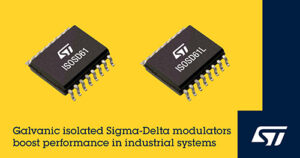STMicroelectronics‘ ISOSD61 and ISOSD61L are high-accuracy isolated, second-order sigma-delta modulators that deliver enhanced performance and reliability in industrial applications — such as motor control, electric-vehicle charging stations, solar inverters, UPS, as well as server and telecom power supplies.
 The ISOSD61 has TTL/CMOS-compatible clock-input and data-output signal levels, while the ISOSD61L is compatible with Low-Voltage Differential Signaling (LVDS). Both types feature 16-bit analog-to-digital converter (ADC) resolution and a typical Signal-to-Noise Ratio (SNR) of 86dB.
The ISOSD61 has TTL/CMOS-compatible clock-input and data-output signal levels, while the ISOSD61L is compatible with Low-Voltage Differential Signaling (LVDS). Both types feature 16-bit analog-to-digital converter (ADC) resolution and a typical Signal-to-Noise Ratio (SNR) of 86dB.
The embedded galvanic-isolation technology of these devices eliminates the degradation associated with alternative opto-coupled converters, as well as lowering power consumption and allowing much faster data transmission. They also convert an analog input signal with an amplitude of up to ±320mV into a high-speed 1-bit digital data stream at up to 25Msamples/s. Isolation between the two sides.
It’s guaranteed up to 6kV maximum transient and surge isolation voltages and up to 1.2kV maximum working voltage, under normal working conditions. The devices feature 30kV/μs common-mode transient immunity, ensuring an excellent rejection of fast transient noise that can frequently occur in harsh, industrial environments.
Thanks to the external 25MHz sampling frequency, the modulators fit very wide input signal bandwidths. This translates into high-frequency signal-processing capability and measurement accuracy, ready for the latest inverter technologies and fast switching in high-resolution motor-control applications that leverage advanced power technologies, such as silicon carbide (SiC).
By integrating the ADC and isolated UART peripheral functions into a single chip, the ISOSD61 and ISOSD61L help reduce the bill of materials and increase noise immunity and reliability, lowering overall end-application cost. Discrete current sensors are not required, being replaced by small shunt resistors.
The devices are housed in a SO16W surface-mount plastic package, which fulfills 8mm creepage and clearance requirements. They are qualified over an extended industrial temperature range of -40° to +125° C.
Two full-featured evaluation boards are available. The EVALST-ISOSD61T for the ISOSD61 and EVALST-ISOSD61L for ISOSD61L provide coaxial and header pins for connecting to the inputs and outputs, with additional pads for a shunt current sensor.
Filed Under: Components, News


Questions related to this article?
👉Ask and discuss on Electro-Tech-Online.com and EDAboard.com forums.
Tell Us What You Think!!
You must be logged in to post a comment.